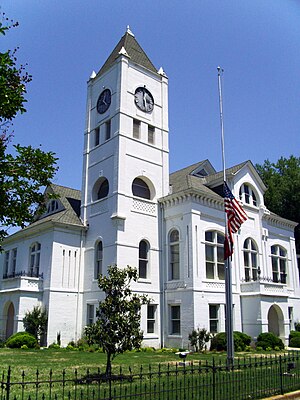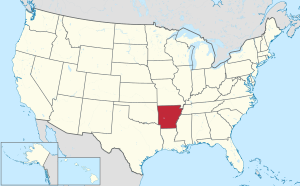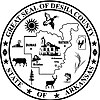Desha County (/dəˈʃeɪ/ duh-SHAY) is a county located in the southeast part of the U.S. state of Arkansas, with its eastern border the Mississippi River. At the 2020 census, the population was 11,395. The county is plurality-African American.[1] The county seat is Arkansas City.[2]
Desha County | |
|---|---|
 Desha County courthouse in Arkansas City | |
 Location within the U.S. state of Arkansas | |
 Arkansas's location within the U.S. | |
| Coordinates: 33°45′28″N 91°17′14″W / 33.7578°N 91.2872°W | |
| Country | |
| State | |
| Founded | December 12, 1838 |
| Named for | Benjamin Desha |
| Seat | Arkansas City |
| Largest city | Dumas |
| Government | |
| • County Judge | Richard Tindall |
| Area | |
• Total | 820 sq mi (2,100 km2) |
| • Land | 768 sq mi (1,990 km2) |
| • Water | 51 sq mi (130 km2) 6.3% |
| Population (2020) | |
• Total | 11,395 |
| • Density | 14/sq mi (5.4/km2) |
| Time zone | UTC−6 (Central) |
| • Summer (DST) | UTC−5 (CDT) |
| Congressional district | 1st |
| Website | deshacounty |
History
editDesha County was created by the Arkansas Legislature on December 12, 1838, consisting of the lands of Arkansas County separated from the county seat by the Arkansas River and the White River, and land from Chicot County. The county was named for Captain Benjamin Desha, who fought in the War of 1812.[3][4]
Located in the Arkansas Delta, Desha County's rivers and fertile soils proved to be prosperous for planters under the cotton-based slave society of plantation agriculture in the antebellum years. After the Civil War, cotton continued as the primary commodity crop into the early 20th century, and planters did well. Labor was provided by sharecroppers and tenant farmers.[citation needed]
But following widespread farm mechanization, laborers were thrown off the land, and Desha County had a demographic and economic transformation. Thousands of African-American farm workers left the area and went north or west in the Great Migration, and there was a decline in population. Farm holdings have been consolidated into industrial-scale farms, with few governmental benefits for small farmers, and the economy cannot support much activity. In the 21st century, the county is seeking to reverse population and economic losses through better education for its workforce, and developing tourism based on its cultural, historical and outdoor recreation amenities.[3]
During World War II, the federal government established the Rohwer War Relocation Center, an internment camp for Japanese nationals and Japanese Americans it forced out of the coastal area of California, the U.S. Pacific Northwest, and Alaska. The camp operated from late 1942 into 1945 and the end of the war, holding up to nearly 8500 ethnic Japanese, many American-born citizens. The Rohwer War Relocation Center Cemetery has been designated as a National Historic Landmark.[citation needed]
Geography
editAccording to the U.S. Census Bureau, the county has a total area of 820 square miles (2,100 km2), of which 768 square miles (1,990 km2) is land and 51 square miles (130 km2) (6.3%) is water.[5] Desha County is within the Arkansas Delta and is considered a member of the Southeast Arkansas region.
Major highways
edit- Future Interstate 69
- U.S. Highway 65
- U.S. Highway 165
- U.S. Highway 278
- Highway 1
- Highway 4
- Highway 138
Adjacent counties
edit- Arkansas County (north)
- Phillips County (northeast)
- Bolivar County, Mississippi (east)
- Chicot County (south)
- Drew County (southwest)
- Lincoln County (northwest)
National protected area
editDemographics
edit| Census | Pop. | Note | %± |
|---|---|---|---|
| 1840 | 1,598 | — | |
| 1850 | 2,911 | 82.2% | |
| 1860 | 6,459 | 121.9% | |
| 1870 | 6,125 | −5.2% | |
| 1880 | 8,973 | 46.5% | |
| 1890 | 10,324 | 15.1% | |
| 1900 | 11,511 | 11.5% | |
| 1910 | 15,274 | 32.7% | |
| 1920 | 20,297 | 32.9% | |
| 1930 | 21,814 | 7.5% | |
| 1940 | 27,160 | 24.5% | |
| 1950 | 25,155 | −7.4% | |
| 1960 | 20,770 | −17.4% | |
| 1970 | 18,761 | −9.7% | |
| 1980 | 19,760 | 5.3% | |
| 1990 | 16,798 | −15.0% | |
| 2000 | 15,341 | −8.7% | |
| 2010 | 13,008 | −15.2% | |
| 2020 | 11,395 | −12.4% | |
| 2023 (est.) | 10,479 | [6] | −8.0% |
| U.S. Decennial Census[7] 1790–1960[8] 1900–1990[9] 1990–2000[10] 2010[11] | |||
2020 census
edit| Race | Num. | Perc. |
|---|---|---|
| White | 4,732 | 41.53% |
| Black or African American | 5,385 | 47.26% |
| Native American | 36 | 0.32% |
| Asian | 61 | 0.54% |
| Other/Mixed | 408 | 3.58% |
| Hispanic or Latino | 773 | 6.78% |
As of the 2020 United States Census, there were 11,395 people, 5,204 households, and 3,545 families residing in the county.
2000 census
editAs of the 2000 census,[14] there were 15,341 people, 5,922 households, and 4,192 families residing in the county. The population density was 20 people per square mile (7.7 people/km2). There were 6,663 housing units at an average density of 9 units per square mile (3.5 units/km2). The racial makeup of the county was 50.50% White, 46.33% Black or African American, 0.35% Native American, 0.30% Asian, 0.03% Pacific Islander, 1.73% from other races, and 0.76% from two or more races. 3.16% of the population were Hispanic or Latino of any race.
There were 5,922 households, out of which 34.60% had children under the age of 18 living with them, 46.50% were married couples living together, 19.90% had a female householder with no husband present, and 29.20% were non-families. 26.90% of all households were made up of individuals, and 12.70% had someone living alone who was 65 years of age or older. The average household size was 2.57 and the average family size was 3.10.
In the county, the population was spread out, with 28.90% under the age of 18, 9.00% from 18 to 24, 25.20% from 25 to 44, 22.70% from 45 to 64, and 14.20% who were 65 years of age or older. The median age was 36 years. For every 100 females, there were 87.60 males. For every 100 females age 18 and over, there were 82.90 males.
The median income for a household in the county was $24,121, and the median income for a family was $30,028. Males had a median income of $29,623 versus $18,913 for females. The per capita income for the county was $13,446. About 23.60% of families and 28.90% of the population were below the poverty line, including 39.60% of those under age 18 and 24.00% of those age 65 or over.
Government
editDesha County had consistently voted Democratic, even as Arkansas as a whole has strongly shifted to the Republican Party and the margins in the county shrinking due to depopulation, voting for the Democratic nominee in every presidential election from 1972 to 2020. In 2020, Joe Biden became the first Democrat since Walter Mondale to fall under 50% in the county, winning a plurality. In 2024, Donald Trump became the first Republican since Richard Nixon in 1972 to win the county.
| Year | Republican | Democratic | Third party(ies) | |||
|---|---|---|---|---|---|---|
| No. | % | No. | % | No. | % | |
| 2024 | 1,805 | 51.50% | 1,638 | 46.73% | 62 | 1.77% |
| 2020 | 1,921 | 46.13% | 2,016 | 48.41% | 227 | 5.45% |
| 2016 | 1,919 | 45.08% | 2,228 | 52.34% | 110 | 2.58% |
| 2012 | 1,896 | 42.90% | 2,443 | 55.27% | 81 | 1.83% |
| 2008 | 1,999 | 42.73% | 2,569 | 54.92% | 110 | 2.35% |
| 2004 | 1,729 | 37.21% | 2,851 | 61.35% | 67 | 1.44% |
| 2000 | 1,603 | 35.66% | 2,776 | 61.76% | 116 | 2.58% |
| 1996 | 978 | 21.48% | 3,230 | 70.94% | 345 | 7.58% |
| 1992 | 1,279 | 22.75% | 3,815 | 67.87% | 527 | 9.38% |
| 1988 | 2,334 | 42.94% | 2,859 | 52.60% | 242 | 4.45% |
| 1984 | 2,696 | 45.87% | 2,918 | 49.64% | 264 | 4.49% |
| 1980 | 2,057 | 34.07% | 3,748 | 62.08% | 232 | 3.84% |
| 1976 | 1,372 | 24.50% | 4,228 | 75.50% | 0 | 0.00% |
| 1972 | 3,385 | 66.92% | 1,665 | 32.92% | 8 | 0.16% |
| 1968 | 972 | 17.00% | 2,270 | 39.71% | 2,474 | 43.28% |
| 1964 | 1,930 | 36.86% | 3,294 | 62.91% | 12 | 0.23% |
| 1960 | 1,063 | 27.01% | 2,502 | 63.57% | 371 | 9.43% |
| 1956 | 1,204 | 28.73% | 2,935 | 70.03% | 52 | 1.24% |
| 1952 | 1,037 | 24.74% | 3,150 | 75.14% | 5 | 0.12% |
| 1948 | 233 | 7.68% | 2,122 | 69.96% | 678 | 22.35% |
| 1944 | 186 | 13.66% | 1,175 | 86.27% | 1 | 0.07% |
| 1940 | 146 | 9.57% | 1,370 | 89.78% | 10 | 0.66% |
| 1936 | 55 | 3.75% | 1,411 | 96.12% | 2 | 0.14% |
| 1932 | 81 | 4.94% | 1,549 | 94.51% | 9 | 0.55% |
| 1928 | 331 | 23.39% | 1,082 | 76.47% | 2 | 0.14% |
| 1924 | 209 | 21.55% | 540 | 55.67% | 221 | 22.78% |
| 1920 | 360 | 27.40% | 931 | 70.85% | 23 | 1.75% |
| 1916 | 369 | 27.77% | 960 | 72.23% | 0 | 0.00% |
| 1912 | 52 | 9.63% | 314 | 58.15% | 174 | 32.22% |
| 1908 | 263 | 33.21% | 518 | 65.40% | 11 | 1.39% |
| 1904 | 82 | 28.57% | 204 | 71.08% | 1 | 0.35% |
| 1900 | 168 | 33.27% | 328 | 64.95% | 9 | 1.78% |
| 1896 | 290 | 40.50% | 396 | 55.31% | 30 | 4.19% |
Communities
editCities
edit- Arkansas City (county seat)[16]
- Dumas
- McGehee
- Mitchellville
- Tillar (partly in Drew County)
- Watson
Towns
editUnincorporated areas
editHistoric community
editTownships
editTownships in Arkansas are the divisions of a county. Each township includes unincorporated areas; some may have incorporated cities or towns within part of their boundaries. Arkansas townships have limited purposes in modern times. However, the United States census does list Arkansas population based on townships (sometimes referred to as "county subdivisions" or "minor civil divisions"). Townships are also of value for historical purposes in terms of genealogical research. Each town or city is within one or more townships in an Arkansas county based on census maps and publications. The townships of Desha County are listed below; listed in parentheses are the cities, towns, and/or census-designated places that are fully or partially inside the township. [17][18]
- Bowie (most of McGehee)
- Clayton (Reed, Tillar, small part of McGehee)
- Franklin (Arkansas City)
- Halley (small part of McGehee)
- Jefferson
- Mississippi
- Randolph (Mitchellville, most of Dumas)
- Red Fork (Watson)
- Richland
- Silver Lake
- Walnut Lake
Notable people
editSee also
editReferences
edit- ^ "Census - Geography Profile: Desha County, Arkansas". United States Census Bureau. Retrieved January 19, 2023.
- ^ "Find a County". National Association of Counties. Archived from the original on May 31, 2011. Retrieved June 7, 2011.
- ^ a b "Desha County". Encyclopedia of Arkansas History & Culture. The Central Arkansas Library System. 2009. Retrieved June 29, 2014.
- ^ Gannett, Henry (1905). The Origin of Certain Place Names in the United States. Govt. Print. Off. pp. 105.
- ^ "2010 Census Gazetteer Files". United States Census Bureau. August 22, 2012. Retrieved August 26, 2015.
- ^ "Annual Estimates of the Resident Population for Counties: April 1, 2020 to July 1, 2023". United States Census Bureau. Retrieved March 30, 2024.
- ^ "U.S. Decennial Census". United States Census Bureau. Retrieved August 26, 2015.
- ^ "Historical Census Browser". University of Virginia Library. Retrieved August 26, 2015.
- ^ Forstall, Richard L., ed. (March 27, 1995). "Population of Counties by Decennial Census: 1900 to 1990". United States Census Bureau. Retrieved August 26, 2015.
- ^ "Census 2000 PHC-T-4. Ranking Tables for Counties: 1990 and 2000" (PDF). United States Census Bureau. April 2, 2001. Archived (PDF) from the original on March 27, 2010. Retrieved August 26, 2015.
- ^ "State & County QuickFacts". United States Census Bureau. Archived from the original on July 28, 2011. Retrieved May 20, 2014.
- ^ Based on 2000 census data
- ^ "Explore Census Data". data.census.gov. Retrieved December 7, 2021.
- ^ "U.S. Census website". United States Census Bureau. Retrieved May 14, 2011.
- ^ "Dave Leip's Atlas of U.S. Presidential Elections". Retrieved November 18, 2016.
- ^ "AR Census Data - Arkansas Economic Development Institute". Arkansas Economic Development Institute. Retrieved August 28, 2018.
- ^ 2011 Boundary and Annexation Survey (BAS): Desha County, AR (PDF) (Map). U. S. Census Bureau. Archived from the original (PDF) on October 19, 2012. Retrieved August 21, 2011.
- ^ "Arkansas: 2010 Census Block Maps - County Subdivision". United States Census Bureau. Retrieved May 28, 2014.
